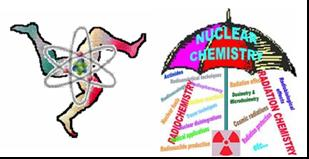Speaker
Susanta Lahiri
(Saha Institute of Nuclear Physics)
Description
Nowadays molybdenum nanoparticle is highly demanding in industry. Molybdenum trioxide (MoO3), as a wide band gap n-type semiconductor, is one of the most intriguing transition metal oxides.
There are various kinds of techniques for synthesis of molybdenum trioxide nanoparticle e.g. chemical route, sol-gel chemistry method, vapor deposition, electro-deposition, flash evaporation, ultrasonic irradiation, etc. In few cases external γ-radiation e.g. 60Co was employed for synthesis of molybdenum nanoparticle. However there are no reports on synthesis of molybdenum nanoparticle using in-situ minute amount of radioactive isotopes. Previously we have synthesised gold nanoparticle and gold-palladium bimetallic nanoparticle1, 2 with the help of minute amount (less than 1 μCi) 198Au (2.69d).
In this work we report synthesis molybdenum trioxide nanoparticle with the help of minute amount of 99Mo (66h). In the mixture of ammonium molybdate (10-6M) and sodiumdodecyl sulphate (SDS) (0.5% w/v) we added 0.02 μCi 99Mo solution. The pHs (2 and 7) of the mixture solutions was then maintained by addition of dilute HCl and dilute ammonia solution as and when necessary. After cooling period of 30 days, 99Mo was completely decay out, and formation of MoO3 nanoparticles was checked by Transmission Electron Microscope (TEM), UV-vis, and Fluorescence spectroscopy. UV-vis absorption study showed that band between 200 to 390 nm with charge transfer in Mo-O bond. Molybdenum trioxide showed a strong emission peak at 432 nm and 428 nm at pH 7 and pH 2 respectively. TEM image revealed the presence of spherical (10-60 nm) size at pH 7 and nanowires of MoO3 nanoparticle of 2-10 nm width and length 0.5-4 μm at pH 2.
The developed method is environmentally benign and found efficient to produce molybdenum trioxide nanoparticle.
Reference:
(1) Roy, K.; Lahiri, S. Gren. Chem. 2006, 8, 1063.
(2) Roy, K.; Lahiri, S. Anal. Chem. 2008, 80, 7504
Author
Susanta Lahiri
(Saha Institute of Nuclear Physics)
Co-author
Mr
Swadesh Mandal
(Saha Institute of Nuclear Physics)
